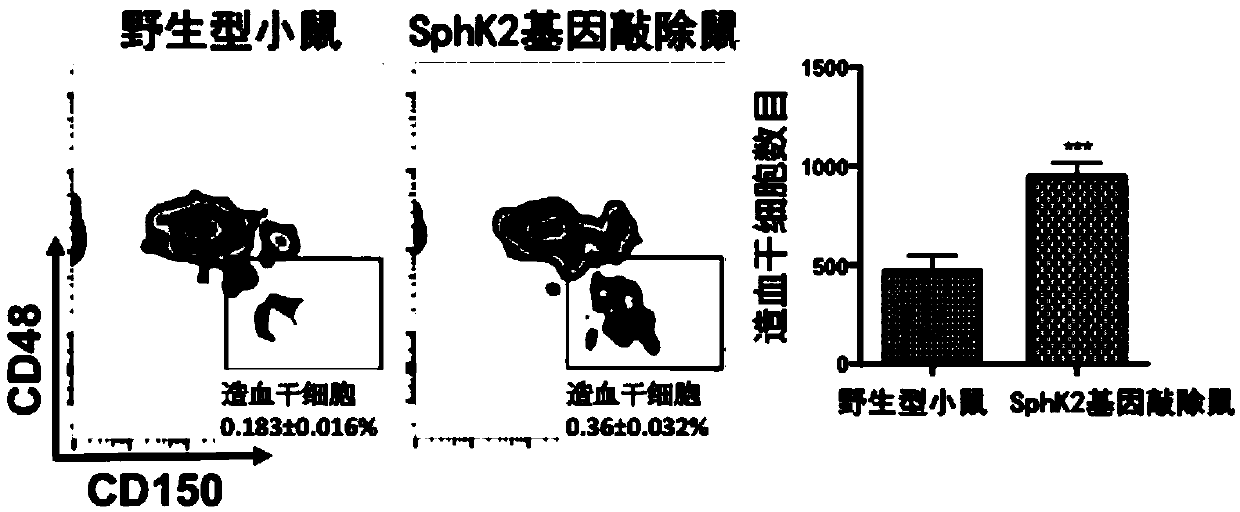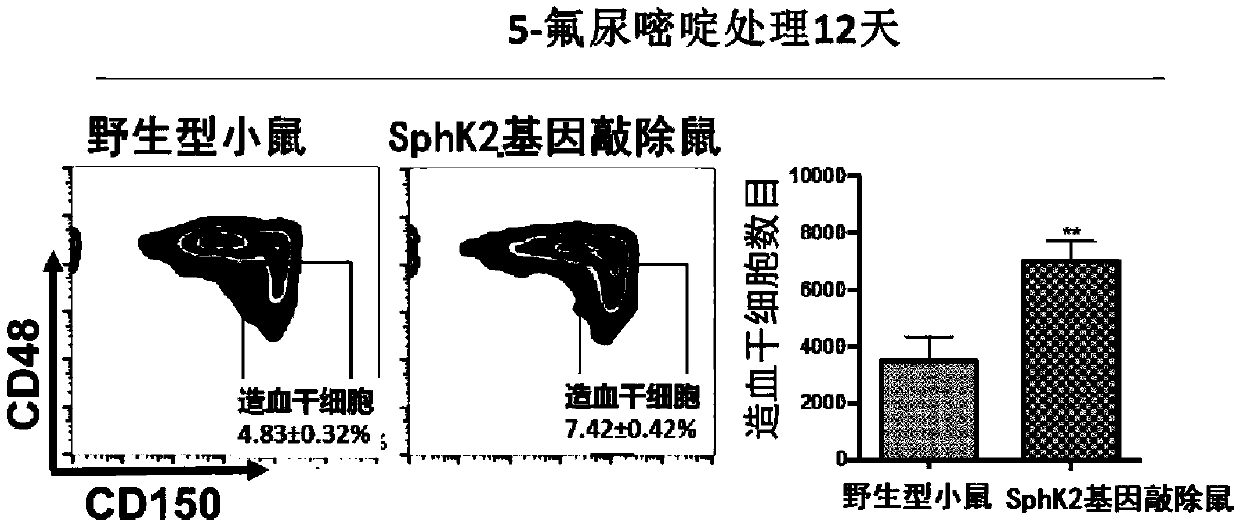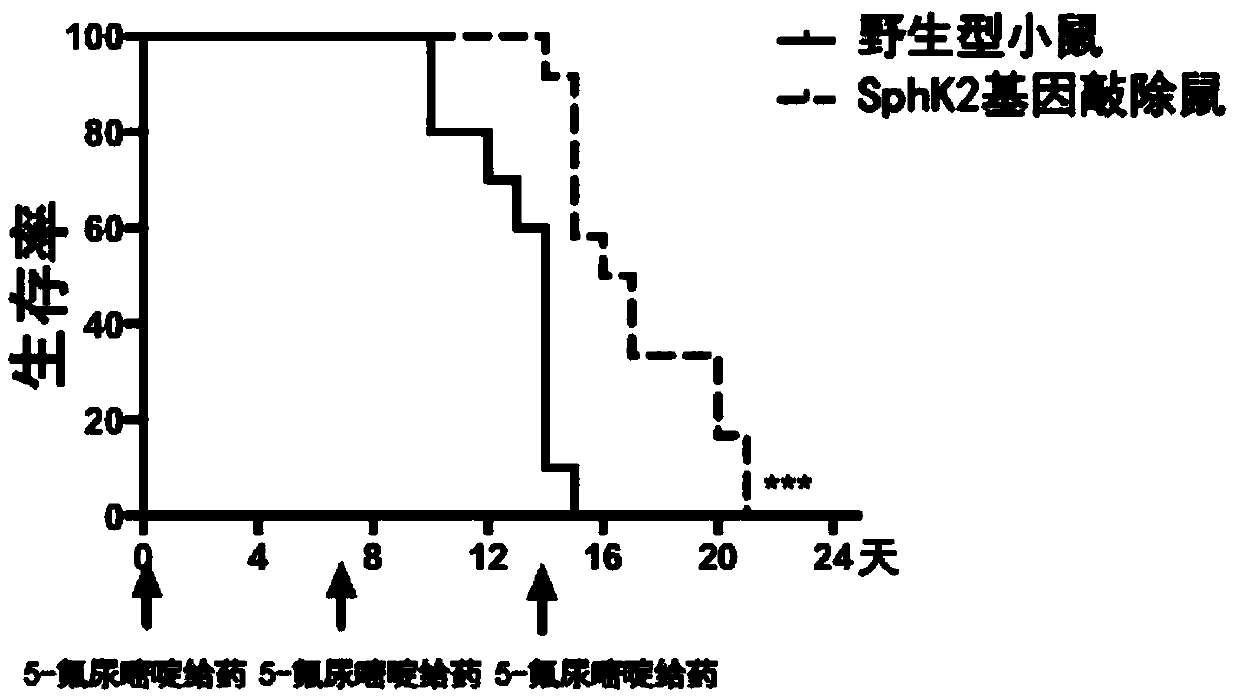Drug for treating bone marrow hematopoietic dysfunction
A technology of hematopoietic function and medicine, applied in the field of medicine
- Summary
- Abstract
- Description
- Claims
- Application Information
AI Technical Summary
Problems solved by technology
Method used
Image
Examples
Embodiment 1
[0032] The SphK2 knockout mouse model was used to show that SphK2 knockout can increase the number of hematopoietic stem cells in the mouse bone marrow under normal physiological conditions.
[0033] SphK2 knockout mice were introduced from the National Institutes of Health (NIH) of the United States, and their background was C57BL / 6J, and they were raised in a specific pathogen-free (SPF) environment. First, we selected wild-type mice and SphK2 knockout mice, 6-8 weeks old, 6 in each, and killed them by neck dislocation, took their femurs and tibias, and flushed them out of the bone marrow cavity with a 1 ml syringe. The bone marrow was blown into a single cell suspension, and the red blood cell lysate was lysed for 2 minutes to remove the red blood cells, and filtered through a 70um filter to obtain a bone marrow single cell suspension. In order to calculate the number of hematopoietic stem cells in mice, the molecular marker system Lin-Sca-1+c-Kit+CD150+CD48- recognized in ...
Embodiment 2
[0036] Using the chemotherapy drug 5-fluorouracil to induce bone marrow hematopoietic system damage in mice, it was found that the damage repair ability of hematopoietic stem cells in SphK2 knockout mice was significantly enhanced.
[0037] The wild-type mice and SphK2 gene knockout mice in the feeding environment in Example 1 were selected respectively, 6-8 weeks old, and the number was 6. For intraperitoneal injection of 5-fluorouracil, the injection dose was 150 mg / kg, and after 12 days, the It was killed by neck dislocation, and its femur and tibia were taken, and the analysis process of other materials was the same as in Example 1. We used Graphpad6.0 for t-test analysis, and marked the significance of the difference with P<0.05.
[0038] The results showed that after 5-fluorouracil stimulation for 12 days, the number of hematopoietic stem cells in the bone marrow cells of the SphK2 gene knockout group was significantly more than that of the wild-type mouse group ( figu...
Embodiment 3
[0040] The survival period of SphK2 knockout mice is significantly longer than that of wild-type mice
[0041] The wild-type mice and the SphK2 gene knockout mice in the feeding environment in Example 1 were selected respectively, 8 weeks old, and the number was 10 each. For intraperitoneal injection of 5-fluorouracil, the injection dose was 150 mg / kg, once every 7 days , played continuously for 3 weeks, and observed the survival cycle of the mice ( image 3 ). We used Graphpad6.0 for t-test analysis, and marked the significance of the difference with P<0.05.
[0042] The results showed that the survival period of the SphK2 knockout mice group was significantly longer than that of the wild-type mice group under multiple 5-fluorouracil stimulations, indicating that the SphK2 knockout mice were more able to resist the chemotherapy damage induced by 5-fluorouracil, ** *P<0.001.
PUM
 Login to View More
Login to View More Abstract
Description
Claims
Application Information
 Login to View More
Login to View More - R&D
- Intellectual Property
- Life Sciences
- Materials
- Tech Scout
- Unparalleled Data Quality
- Higher Quality Content
- 60% Fewer Hallucinations
Browse by: Latest US Patents, China's latest patents, Technical Efficacy Thesaurus, Application Domain, Technology Topic, Popular Technical Reports.
© 2025 PatSnap. All rights reserved.Legal|Privacy policy|Modern Slavery Act Transparency Statement|Sitemap|About US| Contact US: help@patsnap.com



